|
DiveHatteras
Homepage
Shipwrecks
Hatteras
Diving
Dive
Charters
The
Dive
Boat
Dive
Link
Weather
Area
Info
Eats&Treats
About
Us
Dive
Photos
Ann's
Seashells
Divers
Dive
Reports
FAQs
Site
Map
|
When you jump off our dive boat in
Hatteras there is really no way to know in advance just what sea life
you are going to encounter. The influence of the two major
currents of the North Atlantic, the Labrador and the Gulf Stream, bring
us a wide variety of sea life from small tropical fish to large pelagic
species. Many of these large fish are sharks and that is what many
divers come to Hatteras to see.
Just what type of shark you might
encounter on any particular dive is really never known in advance.
Our most common specie, the Sand Tiger (Carcharias Taurus), is often
present. However, the same dive site may have none one day and
many hundreds the next. Many other species may be commonly seen
and some are only rarely sighted while diving.
The sharks we see are listed here in the
general order of the most common to the rarely seen.
|
Sand Tiger Shark - (Carcharias taurus)
The Sand Tiger is the most common shark
seen when diving the Hatteras area. It may congregate on the wreck
sites in extremely large numbers during the summer season. You may
not see any at a wreck site, then you may find hundreds of them there
the next time you dive the same site. They are often more
plentiful at the deeper wrecks sites, but may be in large numbers on an
inshore shallow site as well. At the Proteus wreck I have
experienced dives when I could see at least a hundred of these sharks in any
direction. On several occasions at the end of the dive I have
pulled the anchor and drifted underwater with the current for over 1/4
mile and found there were just as many sharks away from the wreck as
were seen at the wreck site. The Sand Tiger is also
known to patrol the beach in the area just beyond the breakers and was often
caught by persons shark fishing from the beach when that was a
popular activity.
|
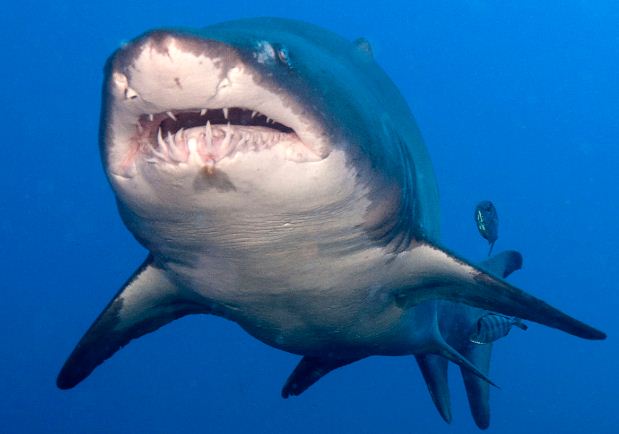
Large Sandtiger photo courtesy
of Diver Michael Weiss
|
|
The Sand Tiger is a world wide specie and
is known as the Ragged Tooth Shark off Africa and the Grey Nurse in
waters of Australia.
Here off the East Coast of the US, they grow to be 10 to 12 feet in
length and are a very large full bodied shark. The males tend to
be smaller and less bulky than the females, which can grow to be 10 to
12 feet and very large in girth. They are know to be live bearers
of usually two pups, the survivors of intrauterine cannibalism, and along the US coast the main
pupping grounds are
believed to be the Delaware and Chesapeake Bays with the pups remaining in
these waters until about 3 to 4 feet in length.
The Sand Tiger is considered by most
divers to be a docile and harmless shark. However, this is a
misconception and these sharks should be given the respect any apex predator
deserves. Though most of the time the Sand Tiger is seen moving
slowly and appears to be almost lazy, this is just their daytime
"energy conservation mode". When there are feeding opportunities,
this shark moves extremely rapidly and is tenacious in obtaining it's
meal. Having observed their feeding activity as well as providing
them more than one meal when I have been spearfishing, I have respect
for these sharks and suggest that other divers do likewise.
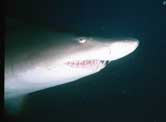
|
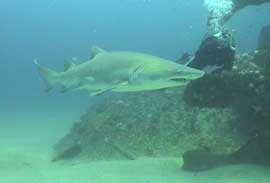
A sandtiger swims past Capt Dave
on the Dixie Arrow
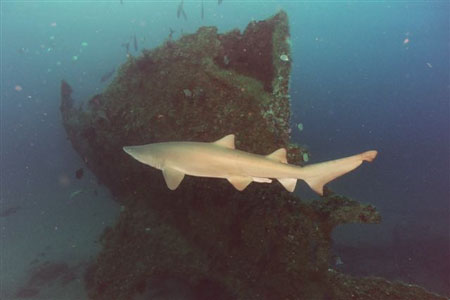
Sandtiger at the
Proteus wreck is courtesy of Diver Wade Pryor |
|
Nurse Shark - (Ginglymostoma cirratum)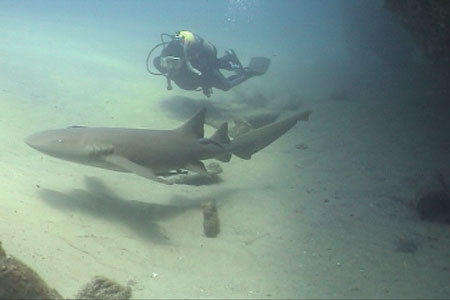
The Nurse shark is most often seen at the
wreck sites in the area of the Diamond Shoals, but it is an occasional
visitor at the deeper southern sites as well. You will most often
encounter the Nurse shark tucked under or beside a piece of the wreck at
the sand level where it is resting and waiting for dark when it
feeds. They can reach lengths of up to 10 feet, we see them mainly
in the 5 to 8 foot range. The Nurse as a species are known to
congregate during their daytime naps, but sightings of more than one
Nurse at a time are not that common in our diving area.
|
|
Bull Shark - (Carcharhinus leucas)
When the average person thinks about the
shape of a shark, the Bull Shark is probably pretty close to what they
would describe. Bull Sharks have the "typical" shark
look with a stiff fairly prominent dorsal fin that is almost triangular
in appearance and a broad stocky body. Their pectoral fins are
about twice the length of the dorsal and appear to be stick stiffly out
from the body. Their swimming motion is distinct from many of the
other sharks you may see in Hatteras and looks like it originates from
the shoulder area and they move along very quickly with little effort
and this gives the impression of a "shark on a mission".
When you see the Bull Shark on the wreck
site they will often be continually moving almost as if constantly on
patrol. I have watched them swim the perimeter of the wreck site
the 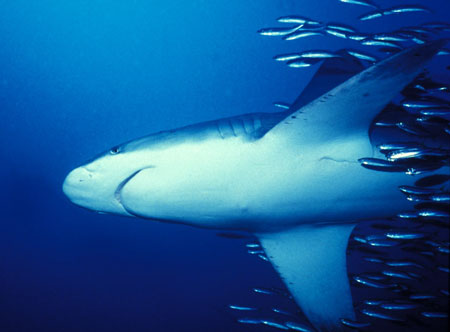 entire time I was making a dive and never once did they break the
pace. They have often swam close to me making just one inspection
pass then continue on their patrol. I have also seen them rise up
from below when I was doing a deco under the boat, look me over, then
just fade back down to the depths. Perhaps a bit disconcerting,
but once they take a look they have always gone on their
way. entire time I was making a dive and never once did they break the
pace. They have often swam close to me making just one inspection
pass then continue on their patrol. I have also seen them rise up
from below when I was doing a deco under the boat, look me over, then
just fade back down to the depths. Perhaps a bit disconcerting,
but once they take a look they have always gone on their
way.
World-wide, the Bull Shark is known by a
variety of different names depending upon the location. It has a
fairly bad reputation as a dangerous shark throughout most of it's range
and this specie was identified as responsible for a fatal attack on the
Hatteras beach in 2001. We have not had any
direct problems with the Bull Shark, but if they are around on the dive
site I do not do any spear fishing and they seem to be ok with that.
Diver Joe Poe took the photo displayed
here while shipwreck diving in the waters off Hatteras.
|
|
Lemon Shark - (Negaprion
brevirostris)
The Lemon Shark gets the name from the
color of the under belly, which when diving at depth with the shark is
not always immediately apparent other than that you notice the underside
is distinctly lighter in color than the top of the shark. We do
not always see the Lemons on the wreck sites, but when we do they are
often in pairs or small groups of three or four sharks. The ones
that we have seen usually range in size of up to approximately 7 to 8
feet. At first glace they may seem to be the more common Sandtiger,
but they do have some very distinct features that differentiate the two
species. Compared to the Sandtigers, the Lemons have much sleeker pectoral
fins and the two dorsal fins are of almost the same size. They
always appear to me to be much more active swimmers than the Sandtigers
and tend to move more quickly. They also appear to be
inquisitive of the divers and will make one or two passes before
swimming off. They are usually seen on the moderate depth
dives and not often at the deeper offshore sites.
|
|
Dusky Shark - (Carcharhinus
obscurus)
The Dusky shark is not seen in
great numbers or with consistent frequency but enough to know this
specie is here is some numbers. It will not normally be seen
while diving the wreck site on the bottom, but in the water column
or at the surface. I have seen them many times when fishing
for Mahi or Wahoo along the Sargasso weed lines that form along
the edges of the current rips and on occasion at the surface on
the wreck sites.
The Dusky looks dark blue/grey on
the topside with the typical counter shading along the lateral
line and then almost white on the belly. They have a pretty
typical "sharky look" to them with one dominant dorsal
fin that has a curved front edge that ends in a slightly rounded
tip. Dusky sharks that I have seen had just the hint of very
dark coloration on the back ends of the pectoral and dorsal
fins. They are often called by several other names, Brown
Shark, Bronze Whaler, as well as the Shovelnose Shark (often used
by the local Hatteras commercial fishermen).
According to the literature, a full
grown Dusky can reach 12 feet in length, but I have not seen one
of that size class in Hatteras just ones of up to around 6 to 7
feet. The Dusky is reported to be a slow growth shark taking
up to 20 years to reach full size and they may live for up to 45
years. The population of Dusky sharks is heavily affected by
commercial long line fishing and they are regularly taken as
by-catch in the Sword and Tuna fisheries. Though this is a
poor end for a creature like this, they do
not go to waste as they are finned for soup and the flesh sold to
become fish n chips. Still, not a good thing for such a slow
growth resource and they are listed as Vulnerable and
Threatened.
|
|
Silky Shark - (Carcharias falciformis)
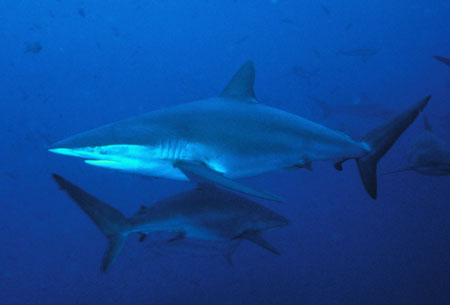 The Silky is a shark that we do not
always see on the wreck sites, but for some reason there were several of
them noted during the 2010 dive season. One day in August, they
were sighted on the surface at the Dixie Arrow during our surface
interval. A group of them were attracted to the float at the end
of the tag line and had a game of knock the float around for a few
minutes. The Silky is an active shark that swim fairly quickly with a smooth distinct
motion, when you see one glide past you will know what I mean.
However, it gets the name from their very smooth hides and not the
swimming style.
When diving, the largest Silky I have seen in Hatteras has been in the 6
foot range, but when farther offshore Tuna fishing I have seen them
closer to ten feet in length. In the 2013 and 2014 dive seasons,
we have had many more Silky sightings than in the past so maybe their
numbers are on the increase. The Silky is a shark that we do not
always see on the wreck sites, but for some reason there were several of
them noted during the 2010 dive season. One day in August, they
were sighted on the surface at the Dixie Arrow during our surface
interval. A group of them were attracted to the float at the end
of the tag line and had a game of knock the float around for a few
minutes. The Silky is an active shark that swim fairly quickly with a smooth distinct
motion, when you see one glide past you will know what I mean.
However, it gets the name from their very smooth hides and not the
swimming style.
When diving, the largest Silky I have seen in Hatteras has been in the 6
foot range, but when farther offshore Tuna fishing I have seen them
closer to ten feet in length. In the 2013 and 2014 dive seasons,
we have had many more Silky sightings than in the past so maybe their
numbers are on the increase.
The photo shown of Silky Sharks is
courtesy of Diver Joe Poe.
|
|
SandBar Shark - (Carcharhinus
plumbeus)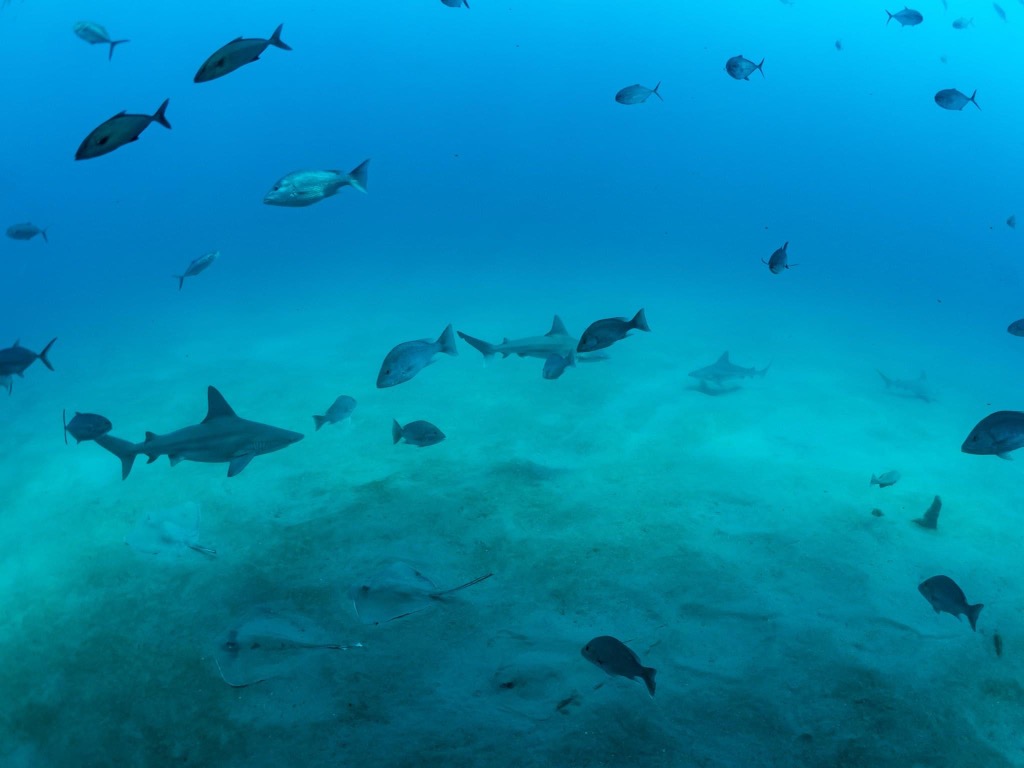
We are seeing an increasing number of SandBar
Sharks on the Hatteras wrecks. When they are present they seem
to be a a pack of 4 to 12 sharks, at least that's what we seem to
encounter. The photo to the right, taken by Marc
Corbett, shows several Sandbars at the Dixie Arrow wreck in June of
22.
Sandbars resemble the Bull Shark at
first glance but have a much taller and prominet dorsal fin and
longer pectorials. Like the Bullshark, they seem to be an
active swimmer and keep on the move around the wreck site. So
far there have been no negitive interactions with this specie and
that is in keeping with their general reputation.
The Sandbars grow to a
maximum of about 6.5 to 8 feet with the males being generally
smaller. Like the Sandtigers, it is believed they pup in the
Cheasapeake and Deleware bays as many juvenile sharks are found
there. They are preditors of Fish, Rays and Crabs, and
Sandbars are known to be hunted by Tiger Sharks and GWS.
Hammerhead Shark - (Sphyrnidae)
There are many different species of the
Hammerhead shark and I am not exactly sure which species we are
occasionally seeing in Hatteras. When they are 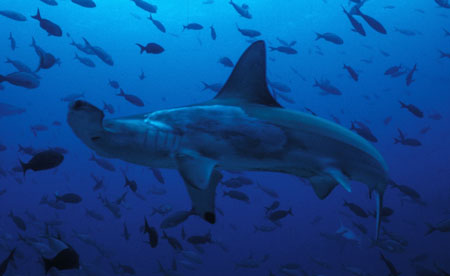 sighted, it is
usually a very fleeting encounter and many times they are sighted at the
surface from the boat and not in the water during a dive. They
seem to show up when the current is strong and they do not tend to hang
around long. The ones that I have seen were 8 to 10 feet in size
and I believe them to be the Scalloped Hammerhead - (Sphyrna
lewini), but I have sighted, it is
usually a very fleeting encounter and many times they are sighted at the
surface from the boat and not in the water during a dive. They
seem to show up when the current is strong and they do not tend to hang
around long. The ones that I have seen were 8 to 10 feet in size
and I believe them to be the Scalloped Hammerhead - (Sphyrna
lewini), but I have
not had a clear enough look to be certain.
Free divers that I know have experienced encounters with them while
spearfishing and they did get closer looks than I have had while using
SCUBA, but they could not be species specific either. Diver
Joe Poe provide the excellent photo of this Hammerhead that is shown
here.
During
the 2010 summer, local commercial fishermen were landing Hammerheads in
limited numbers that range in size to about 300 pounds. These
sharks are caught in nets and landed whole with the fins sold separately
from the meat.
|
|
Tiger Shark - (Galeocerdo
cuvier)
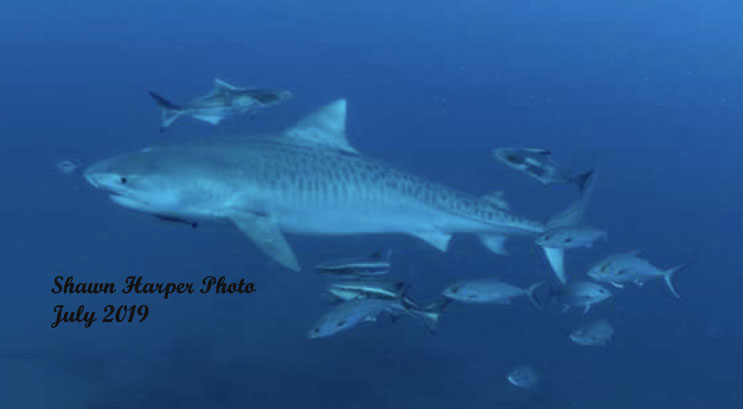 The Tiger Shark has been seen by divers
in Hatteras on a few occasions and have recently become more prevalent. My first sighting of a Tiger was
while diving the Kassandra Louloudis wreck on the Diamond Shoals.
The Tiger shark came up from down current, appeared to be startled
at my presence, swam a slow circle around me and then continued on up current and was not seen again.
Of course I did not have a camera with me, so all I have is the
story. The Tiger Shark has been seen by divers
in Hatteras on a few occasions and have recently become more prevalent. My first sighting of a Tiger was
while diving the Kassandra Louloudis wreck on the Diamond Shoals.
The Tiger shark came up from down current, appeared to be startled
at my presence, swam a slow circle around me and then continued on up current and was not seen again.
Of course I did not have a camera with me, so all I have is the
story.
However, July of 2019 was a different
story. I still did not have a camera but Shawn Harper, who was
diving with me, did and he took this very good pic of the
large tiger shark that came in to investigate us. We were on
some natural live bottom not too far from the Monahan wreck and I
had just speared a nice fish. The Tiger came with many cobia
and other fish swarming about it and quickly began to home in on
where the dead fish was located - attached to me. The Tiger
circled many times, but Shawn's huge strobe set up seemed to keep it
from closing, so up to the boat we went. A very beautiful
shark, even up close and curious.
The Tiger has a very
stout body shape and a rather broad blunt nose. It swims in what
appears to me to be a purposeful manner and there is no question as to
the identity of this shark when seen underwater. The Tiger when
sighted broadside has a variegated "tiger-stripe" pattern that
is distinct. This strip pattern is reported to fade in some sharks as
the they
age but I have not seen ones with faded markings and the ones I have seen
range from about 8 feet to around 14 feet in length. The Hatteras
area Tigers appear to be the same species as the large Tiger Sharks I
have dived with at Isle De Cocos in the Pacific. Adults
Tigers have been reported to be up to 20 feet in length and weigh 1900
pounds.
|
|
Mako Shark - (Isurus oxyrinchus)
The short fin Mako Shark is one that has
been seen on occasion by divers in Hatteras. My first sighting of
one was after a dive on the Manuela. During the deco, the shark
came up from down current and made one half circle pass at about half
the distance of the visibility then
finned off into the haze. The other divers that have spoken to me
about their sightings have also had just brief encounters.
Even with a short encounter the Mako is
easy to identify underwater. It has a very hydrodynamic shape with
a sharp pointy nose. The tail fin is almost crescent shaped and
somewhat symmetrical with the top lobe being a bit larger than the
bottom. The dorsal fin is very triangular with the leading edge
swept back a bit and though the Mako has a second dorsal it is so small
you probably will not notice it right away.
The Mako is often targeted as a sport
fish in waters North of Hatteras and they are not normally fished for by
the sport fishing charters here. However, the short fin Mako is
known to feed on many of the species that frequent our waters in the
spring and fall, so the chance of a sighting should increase if diving
during those seasons.
|
|
Oceanic White Tip Shark - (Carcharhinus
longimanus
)
Only
rarely sighted when diving the Hatteras area, it is a shark that if seen
underwater will not be forgotten. It is a large shark and a fast
swimmer with very distinct pectoral and dorsal fins. The
fins are long and hold stiff from the body, they are very parabolic in shape with very distinct white
tips and look like little surfboards sticking out from the sides and top
of the shark.
This shark has only been seen here when the very warm and blue Gulf
Stream waters are close in and the current strong. My encounter
with one was at the Dixie Arrow site and the shark was very interested
in the divers, left abruptly then returned briefly before
disappearing. The Oceanic White Tip has just recently been
granted a protected status and fishing for them will be strictly
regulated so their numbers may hopefully be increasing in the future.
|
|
Great White Shark - (Carcharodon
carcharias)
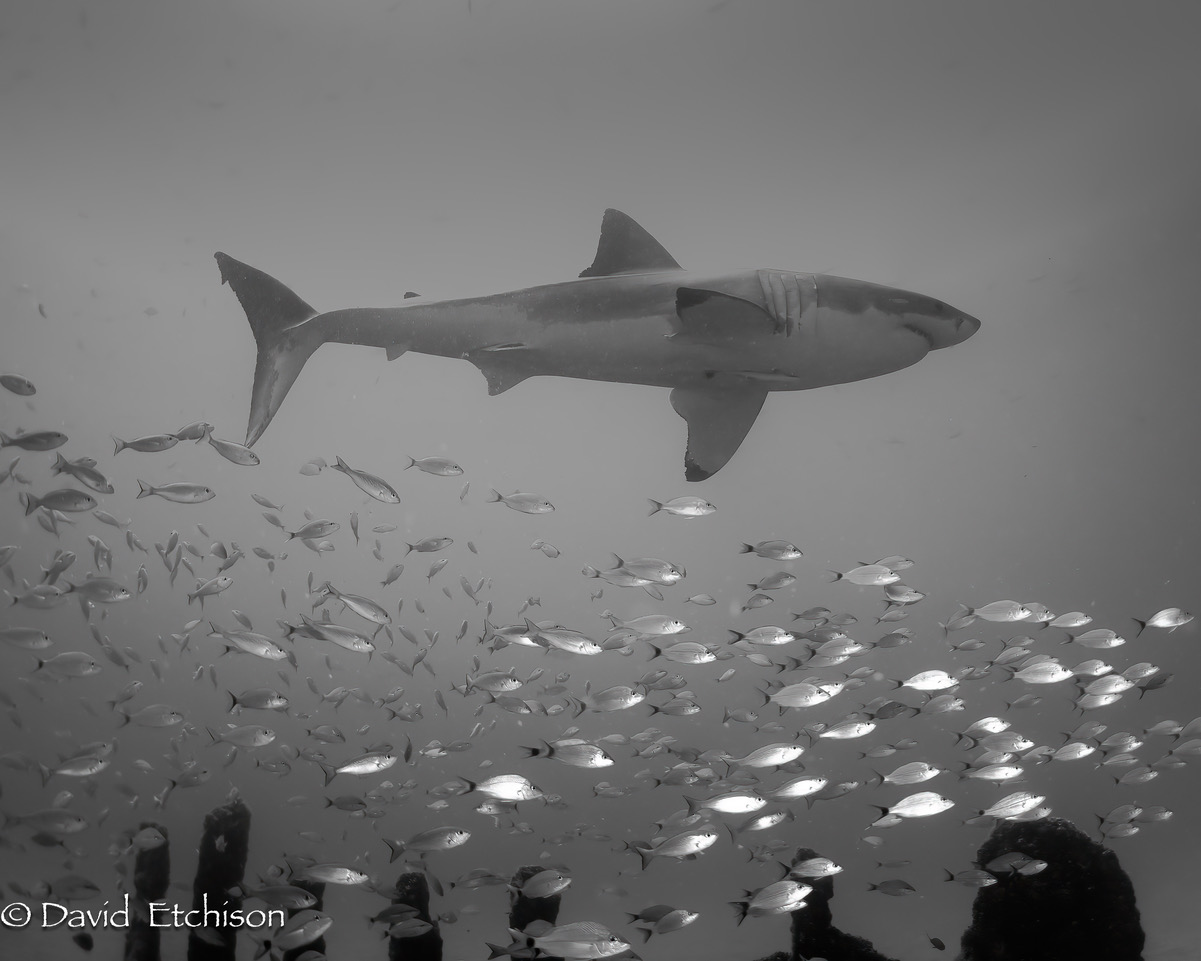 Yes, the star of numerous shark week
episodes has been spotted by divers off the North Carolina coast and in the
Hatteras area. The sightings in our area are somewhat rare but they have
been accurate and are documented with some
underwater photos/videos. The sharks tracked by
Ocean Research are pinged off Hatteras often and we saw one at the
surface out at the Manuela site on one late November dive, that
distinctive dorsal fin just gliding along about 50 yards off. Yes, the star of numerous shark week
episodes has been spotted by divers off the North Carolina coast and in the
Hatteras area. The sightings in our area are somewhat rare but they have
been accurate and are documented with some
underwater photos/videos. The sharks tracked by
Ocean Research are pinged off Hatteras often and we saw one at the
surface out at the Manuela site on one late November dive, that
distinctive dorsal fin just gliding along about 50 yards off.
The photos of GWS were taken June of
2022 at the British Spendour wreck by Diver Dave Etchison.
Notice the size comparison between the 12-14 foot GWS and the
Sandtiger below it.
My first personal encounter with one of
these iconic sharks was not in Hatteras, but off Grand Bahamas
island. I caught a glance of the shark at the edge of my
vision and turned around to see a ten to twelve footer fining past
about 20 feet away. It was instantly apparent that it was a
Great White and it went off into the haze as the other divers
nearby also caught a glimpse of it.
The second brief encounter happened during
the deco stop while the boat was drifting away from the Tarpon wreck
site. The water was very clear and warm as it was in August.
Another diver and I were finishing up a long deco under the boat and
I turned to look behind us and a very, very large shark was just 15
or so feet away and a bit deeper then we were hanging. This
large shark turned and presented a brief downward profile view of
the pectorals and then it turned away and with one flip of the tail
rapidly descended and moved off. The tail was the last view
and it was huge and very distinctly that of the GWS. I
turned to the other diver, but he was gone and heading up the
ladder, I followed quickly. Divers on the boat had not seen a
thing...
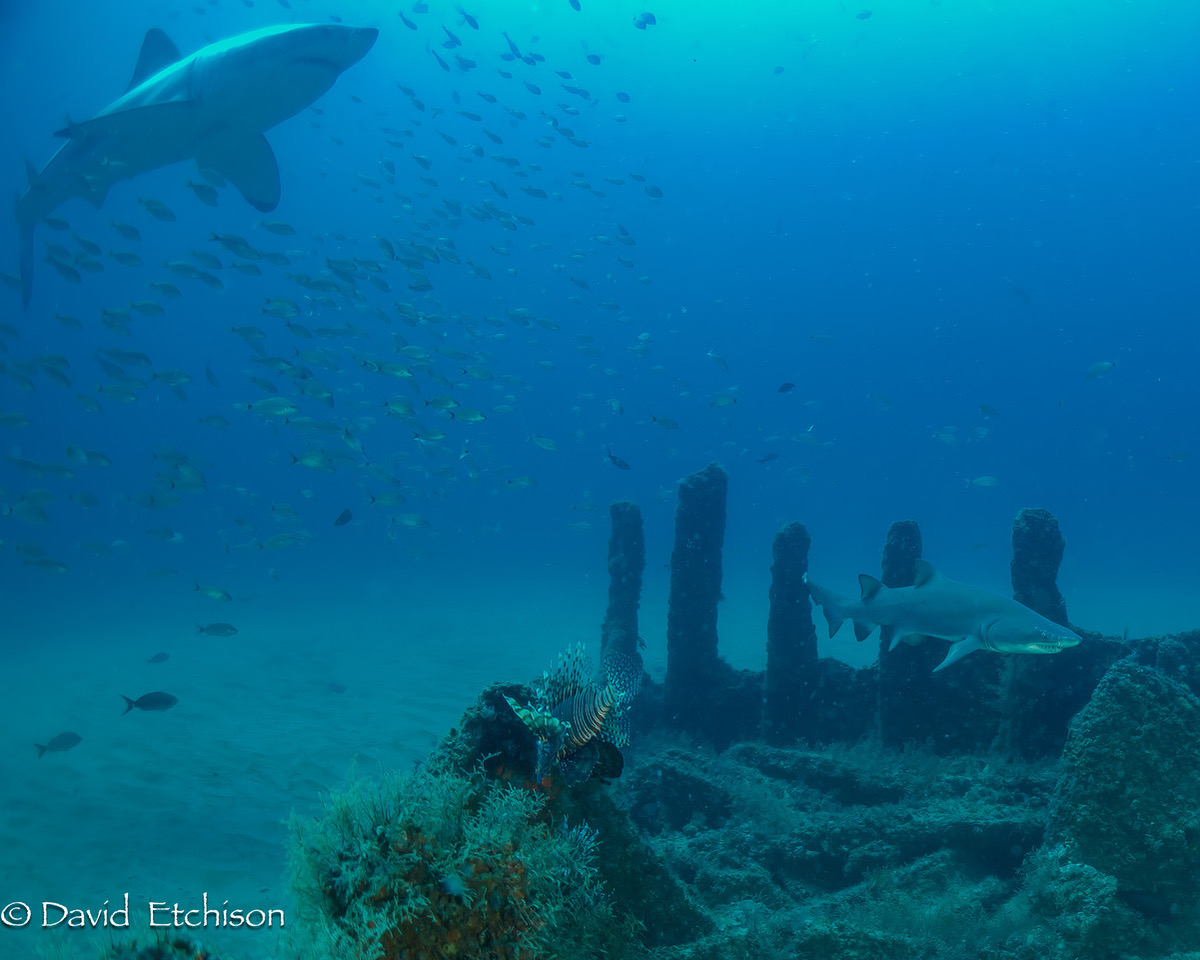 The chances of you actually seeing one of
them while on a dive in Hatteras are really not that good, but I keep looking over
my shoulder anyway. The chances of you actually seeing one of
them while on a dive in Hatteras are really not that good, but I keep looking over
my shoulder anyway.
|
|
Whale Shark - (Rhincodon typus)
Another shark that is somewhat rare to
sight in the Hatteras area is the Whale Shark. It has been
reported by other divers on occasion enough to make it a known visitor
to the area, but not a common one. One reliable sighting was from
an avid free diver I know who saw and dived with a Whale Shark offshore of Ocracoke
at one of the artificial reef sites. The Whale Shark is a plankton
feeder and not a threat to divers despite their size. I am still
waiting for our opportunity to encounter one here in Hatteras.
|
The photos here are taken in the waters
off Hatteras. If you have dived the Hatteras area and have some good
pictures of these sharks and would like to have them added to this page,
email me.
|
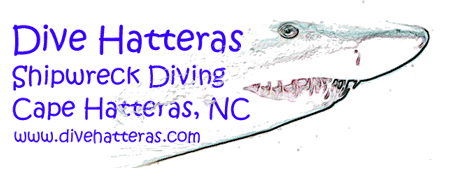 The
Sharks of Hatteras
The
Sharks of Hatteras